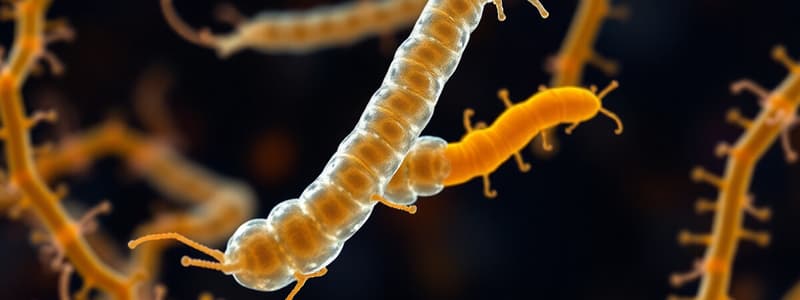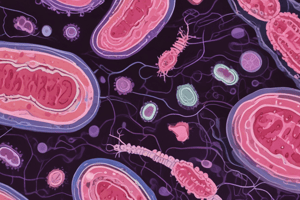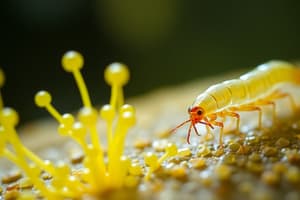Podcast
Questions and Answers
What is the maximum magnification power of a conventional light microscope?
What is the maximum magnification power of a conventional light microscope?
- 150,000 X
- 10,000 X
- 200,000 X
- 1,000 X (correct)
What is the resolving power of a transmission electron microscope?
What is the resolving power of a transmission electron microscope?
- 0.5 mm
- 1-2 nm (correct)
- 0.1 mm
- 0.2 mm
Which of the following components is part of the mechanical system of a conventional optical microscope?
Which of the following components is part of the mechanical system of a conventional optical microscope?
- Objective lens
- Condenser
- Eyepiece
- Stage (correct)
What is the typical numerical aperture for air in optical microscopy?
What is the typical numerical aperture for air in optical microscopy?
Which type of microscopy provides the highest magnification?
Which type of microscopy provides the highest magnification?
What is the resolution limit of the human eye in millimeters?
What is the resolution limit of the human eye in millimeters?
Which system of a conventional light microscope includes the spotlight and diaphragm?
Which system of a conventional light microscope includes the spotlight and diaphragm?
Using which type of microscope would you best observe a polypeptide chain?
Using which type of microscope would you best observe a polypeptide chain?
What does Forward Scatter (FSC) measure in cell analysis?
What does Forward Scatter (FSC) measure in cell analysis?
What is the primary purpose of breaking the plasma membrane in cellular studies?
What is the primary purpose of breaking the plasma membrane in cellular studies?
Which method is commonly used to break down cell membranes for cellular studies?
Which method is commonly used to break down cell membranes for cellular studies?
What does Side Scatter (SSC) indicate during cell analysis?
What does Side Scatter (SSC) indicate during cell analysis?
What is differential centrifugation primarily used for?
What is differential centrifugation primarily used for?
What is the purpose of density gradient centrifugation?
What is the purpose of density gradient centrifugation?
How fast does an ultracentrifuge typically operate?
How fast does an ultracentrifuge typically operate?
Which enzyme is commonly used in enzymatic methods to break down cell walls?
Which enzyme is commonly used in enzymatic methods to break down cell walls?
What is the primary purpose of immunohistochemical techniques?
What is the primary purpose of immunohistochemical techniques?
What allows multiphoton microscopy to emit fluorescence only from the focus plane of the laser?
What allows multiphoton microscopy to emit fluorescence only from the focus plane of the laser?
Which technique is most widely used in immunohistochemistry?
Which technique is most widely used in immunohistochemistry?
What is the theoretical maximum resolution of an electron microscope?
What is the theoretical maximum resolution of an electron microscope?
What staining agents are mentioned for contrasting in electron microscopy?
What staining agents are mentioned for contrasting in electron microscopy?
Which component is NOT part of the flow cytometer?
Which component is NOT part of the flow cytometer?
What limits the resolution of biological samples in transmission electron microscopy (TEM)?
What limits the resolution of biological samples in transmission electron microscopy (TEM)?
Which component modifies the electron beam before it reaches the biological sample in a TEM?
Which component modifies the electron beam before it reaches the biological sample in a TEM?
In flow cytometry, how are cells analyzed?
In flow cytometry, how are cells analyzed?
What essential factor is needed for electron microscopy that prevents in vivo studies?
What essential factor is needed for electron microscopy that prevents in vivo studies?
What characterizes the indirect method of immunohistochemistry?
What characterizes the indirect method of immunohistochemistry?
What is one of the main applications of flow cytometry?
What is one of the main applications of flow cytometry?
Which of the following is a contrast substance commonly used in TEM?
Which of the following is a contrast substance commonly used in TEM?
What is the diameter range for the thickness of samples in transmission electron microscopy?
What is the diameter range for the thickness of samples in transmission electron microscopy?
What is a significant advantage of using indirect immunohistochemical techniques?
What is a significant advantage of using indirect immunohistochemical techniques?
What technique is more powerful than light microscopy for analyzing details of cell structures?
What technique is more powerful than light microscopy for analyzing details of cell structures?
What is the primary purpose of fluorescence microscopy?
What is the primary purpose of fluorescence microscopy?
What distinguishes green fluorescent protein (GFP) in fluorescence microscopy?
What distinguishes green fluorescent protein (GFP) in fluorescence microscopy?
Which microscopy technique is most effective for observing living cells with different refractive indices?
Which microscopy technique is most effective for observing living cells with different refractive indices?
What role does the dichroic mirror play in fluorescence microscopy?
What role does the dichroic mirror play in fluorescence microscopy?
What type of cellular components can be specifically stained using fluorescent dyes?
What type of cellular components can be specifically stained using fluorescent dyes?
Which of the following is NOT a feature of differential interference-contrast microscopy?
Which of the following is NOT a feature of differential interference-contrast microscopy?
What substance is used to stain the nucleus selectively in fluorescence microscopy?
What substance is used to stain the nucleus selectively in fluorescence microscopy?
What is the effect of MitoTracker Red CMXRos on cell observation?
What is the effect of MitoTracker Red CMXRos on cell observation?
What is the primary difference between speed separations and equilibrium separations?
What is the primary difference between speed separations and equilibrium separations?
What role do gradients such as Ficoll, Percol, or Nicodenz play in centrifugation?
What role do gradients such as Ficoll, Percol, or Nicodenz play in centrifugation?
Which statement accurately describes the process of cell culture?
Which statement accurately describes the process of cell culture?
What defines a clone in cell culture?
What defines a clone in cell culture?
How do primary cultures differ from secondary cultures?
How do primary cultures differ from secondary cultures?
Why are tumor-derived cells referred to as immortal cells?
Why are tumor-derived cells referred to as immortal cells?
What milestone in cell biology was achieved in 1951?
What milestone in cell biology was achieved in 1951?
What underlies the process of separating Peripheral Blood Mononuclear Cells (PBMC)?
What underlies the process of separating Peripheral Blood Mononuclear Cells (PBMC)?
Flashcards
Resolving power
Resolving power
The ability of a microscope to distinguish two closely spaced objects as separate entities.
Magnification
Magnification
Ability of the objective lens to make an image appear larger than it actually is.
Light microscopy
Light microscopy
A type of microscopy that uses light to illuminate and magnify a sample.
Electron microscopy
Electron microscopy
Signup and view all the flashcards
Transmission electron microscopy (TEM)
Transmission electron microscopy (TEM)
Signup and view all the flashcards
Scanning electron microscopy (SEM)
Scanning electron microscopy (SEM)
Signup and view all the flashcards
Fluorescence microscopy
Fluorescence microscopy
Signup and view all the flashcards
Super-resolution microscopy
Super-resolution microscopy
Signup and view all the flashcards
Flow Cytometry
Flow Cytometry
Signup and view all the flashcards
Forward Scatter (FSC)
Forward Scatter (FSC)
Signup and view all the flashcards
Side Scatter (SSC)
Side Scatter (SSC)
Signup and view all the flashcards
Cell Disruption
Cell Disruption
Signup and view all the flashcards
Differential Centrifugation
Differential Centrifugation
Signup and view all the flashcards
Density Gradient Centrifugation
Density Gradient Centrifugation
Signup and view all the flashcards
Ultrasound
Ultrasound
Signup and view all the flashcards
Lysozyme
Lysozyme
Signup and view all the flashcards
Multiphoton Microscopy
Multiphoton Microscopy
Signup and view all the flashcards
Heavy Metal Staining in TEM
Heavy Metal Staining in TEM
Signup and view all the flashcards
Resolution
Resolution
Signup and view all the flashcards
Numerical Aperture (NA)
Numerical Aperture (NA)
Signup and view all the flashcards
Resolution Limit
Resolution Limit
Signup and view all the flashcards
Confocal Microscopy
Confocal Microscopy
Signup and view all the flashcards
Speed Separation
Speed Separation
Signup and view all the flashcards
Equilibrium Separation
Equilibrium Separation
Signup and view all the flashcards
Cell Culture
Cell Culture
Signup and view all the flashcards
Primary Culture
Primary Culture
Signup and view all the flashcards
Immortal Cells
Immortal Cells
Signup and view all the flashcards
Embryonic Stem Cells
Embryonic Stem Cells
Signup and view all the flashcards
Differentiated Cells
Differentiated Cells
Signup and view all the flashcards
Cloned Cells
Cloned Cells
Signup and view all the flashcards
What is the principle behind light microscopy staining?
What is the principle behind light microscopy staining?
Signup and view all the flashcards
How is contrast achieved in Electron Microscopy?
How is contrast achieved in Electron Microscopy?
Signup and view all the flashcards
What is Immunohistochemistry?
What is Immunohistochemistry?
Signup and view all the flashcards
What is Direct Immunohistochemistry?
What is Direct Immunohistochemistry?
Signup and view all the flashcards
What is Indirect Immunohistochemistry?
What is Indirect Immunohistochemistry?
Signup and view all the flashcards
What is Flow Cytometry?
What is Flow Cytometry?
Signup and view all the flashcards
Describe the components of a flow cytometer.
Describe the components of a flow cytometer.
Signup and view all the flashcards
How do cells get analyzed in a flow cytometer?
How do cells get analyzed in a flow cytometer?
Signup and view all the flashcards
Differential Interference Contrast (DIC) Microscopy
Differential Interference Contrast (DIC) Microscopy
Signup and view all the flashcards
DAPI (4',6-diamidino-2-phenylindole)
DAPI (4',6-diamidino-2-phenylindole)
Signup and view all the flashcards
Green Fluorescent Protein (GFP)
Green Fluorescent Protein (GFP)
Signup and view all the flashcards
Phase Contrast Microscopy
Phase Contrast Microscopy
Signup and view all the flashcards
Phalloidin
Phalloidin
Signup and view all the flashcards
MitoTracker Red CMXRos
MitoTracker Red CMXRos
Signup and view all the flashcards
Study Notes
E. coli Study Notes
- Under optimal conditions, E. coli divides every 20 minutes.
- Rapid growth requires glucose, salts, and organic compounds like amino acids, vitamins, and nucleic acid precursors.
- Slow growth requires salts, a nitrogen source (e.g., ammonia), and a carbon and energy source (e.g., glucose).
Caenorhabditis elegans Study Notes
- It is a multicellular organism shaped like an elongated tube, thinning at the ends.
- It has 959 somatic cells and 1000-2000 germ cells.
- It is easily reproduced and genetically manipulated in labs.
- Its body is covered in a thin outer cuticle.
- Its body is organized into simple organs and systems, including a digestive system (stoma, pharynx, intestine), sexual organs (gonads), and a rudimentary nervous system.
C. elegans Genome Study Notes
- It was the first multicellular organism to have its genome sequenced (1998).
- Its genome is about 100 million base pairs long and has six chromosomes plus one mitochondrial chromosome.
- It has an estimated 19,000 protein-coding genes.
- About 36% of its genes have human homologues.
Danio rerio Study Notes
- Zebrafish (Danio rerio) are small, active fish common in aquariums.
- Their natural habitat includes calm, sometimes stagnant waters of central Asia, particularly the Ganges region of India.
- Adults are typically 3-5 cm long and 1 cm wide, depending on environmental conditions.
- They have an elongated body shape with a dorsal fin and 5-9 bluish bands that run along their sides.
- Males are golden, while females are silver.
- Their ventral area is whitish/pink, earning them the name "zebrafish."
Stem Cell Organoid Cultures Study Notes
- Various tissues can be cultured using stem cells: intestine, lung, brain, stomach, pancreas, etc.
- Activin A, BMP4, Wnt, FGF, and other growth factors are involved in organoid development.
- ECM embedding is a key component of culture formation.
Organoid Models Study Notes
- 2D and 3D organoid culture models are used.
- 3D models can be better than 2D models, except for some scenarios.
- Animal models are also used for some organoids.
Microscopy Techniques Study Notes
- Optical microscopy types include light field, phase contrast, differential interference contrast (DIC), fluorescence, confocal, and multiphoton.
- Light microscopy - uses visible light to magnify image.
- Phase contrast microscopy - manipulates light to reveal internal structures that are virtually invisible in normal light microscopy.
- DIC microscopy - a contrast enhancing technique that illuminates images with polarized light.
- Fluorescence microscopy - uses fluorescent dyes or proteins to detect specific cellular components.
- Confocal microscopy - employs laser light to focus on a defined spot, eliminating out-of-focus light through pinholes, creating 3D images.
- Multiphoton microscopy - requires multiple photons for excitation of fluorophores, creating highly detailed images with minimal light scatter.
- Electron microscopy (TEM/SEM) - uses electrons rather than light waves, magnifying images much more. TEM magnifies thin slices of specimen while SEM illuminates whole specimens.
- Specimen preparation for light microscopy might use fixing, dehydration, clearing, infiltration, and embedding techniques.
- Staining techniques use dye to enhance contrast.
Flow Cytometry Study Notes
- Flow cytometry analyzes the number, size, and intracellular complexity of cells in a suspension.
- It uses a laser to illuminate cells, allowing for analysis of forward and 90-degree scatter to determine size and complexity/granularity, respectively.
- Flow cytometry can be used to isolate specific cell populations.
- Subcellular components can be separated, purified, and analyzed.
Cell Cultures Study Notes
- The study of cells in a living organism is complex.
- Cells grown in culture can be isolated, survive, and grow under controlled conditions.
- Cultured cells have advantages for research including controlled conditions and ease of observation.
Viruses Study Notes
- Viruses need a host cell to carry out their life cycle.
- Viruses can be studied in host cell cultures.
- Using viruses, scientists can learn more about fundamental cell biology including molecular mechanisms, RNA genes, and oncogene discovery.
Immunohistochemical Techniques Study Notes
- Immunohistochemistry is a technique used to identify specific proteins within tissue sections through the use of antibodies.
- It can be used to analyze diseases, specific proteins, and oncogene overexpression.
- Antibody labeling methods can be direct (primary antibody labeled) or indirect (primary antibody detected by labeled secondary antibody).
Cell Biology Instruments Notes
- Specimen preparation, flow cytometry, subcellular separation, and growth of animal cells are common instruments in cell biology.
- Histological processing (fixation, tissue embedding, sectioning, and staining) is vital for preparing specimen for analysis.
- Specific techniques, like differential centrifugation and density gradient centrifugation, are important for purifying specific organelles and other components within cells.
Studying That Suits You
Use AI to generate personalized quizzes and flashcards to suit your learning preferences.




